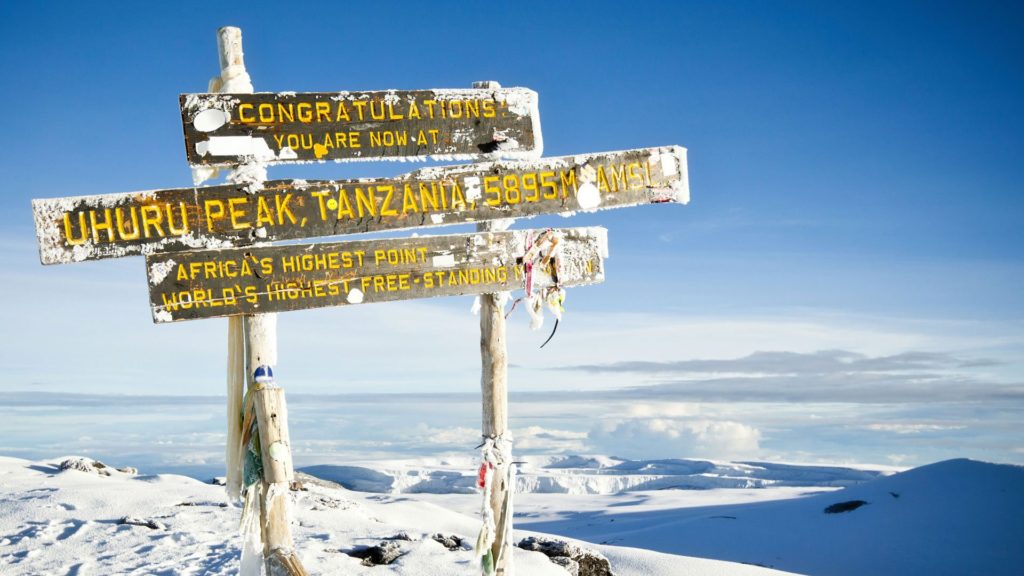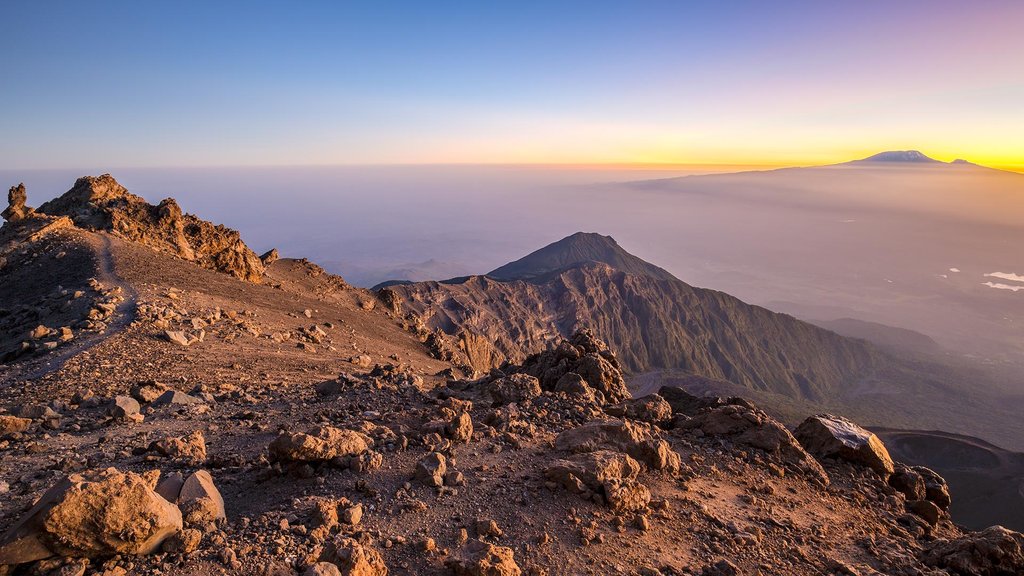Hike Mount Kilimanjaro or Meru
Hiking Mount Kilimanjaro
A dormant volcano in Tanzania. It has three volcanic cones: Kibo, Mawenzi and Shira. It is the highest mountain in Africa and the highest single free-standing mountain in the world: 5,895 meters (19,341 ft) above sea level and about 4,900 meters (16,100 ft) above its plateau base.
Pooja Travel & Tours offers several Kilimanjaro hikes suiting your fitness level, budget and travel time. Climb routes up Kilimanjaro vary in length and difficulty. All except one require you to camp. If you use the Marangu route your accommodation is in huts and camping is not allowed.
Five days is the absolute minimum duration for a Kilimanjaro hike, six is recommended. For the popular Machame route six days is the minimum, seven days is recommended.
Taking an extra day for acclimatization will greatly improve your chances to reach the summit. There are longer treks available for those who can afford them.
We provide everything from hotel transfers in Arusha, to guides and equipment for your climb. Contact us for the Kilimanjaro hike options and cost prices. Book your next climb to the roof of AFRICA today!


Hiking Mount Meru
Hike the little brother of Kilimanjaro with Pooja Travel & Tours! Mount Meru is located just north of the city of Arusha, in the Arusha Region of Tanzania. It is the second-highest mountain in Tanzania, after Mount Kilimanjaro. The Momella route – which starts at Momella gate, on the eastern side of the mountain – is used to climb up Mount Meru.
The hike requires 3 to 4 days and there are two mountain huts on the route. It is a perfect prequel to climbing Kilimanjaro or as a standalone trip.
We provide a total hiking package to guarantee an incredible summit. This includes hotel transfers in Arusha, experienced guide, food and equipment for your climb. Contact us for more information and climb the second highest peak of Tanzania!
Hike F.A.Q.
Few questions which are frequently asked by most of our clients
It is also considered to be the easiest of the Seven Summits to climb, requiring no technical climbing abilities, such as rock climbing or ice climbing. There is some scrambling toward the summit, but the rest of the climb only involves trekking.
Climbing the mountain is considered to be quite achievable for most able bodied people who are in fairly good physical condition. People as old as 80 and as young as 10 have managed to reach the top.
However, the dormant volcano presents some unique challenges of its own. From the base to the summit, you gain altitude very quickly, which can lead to various forms of altitude sickness.
As a result, most mountain guides recommend a very specific set of preparations in order to get prospective climbers ready for the ascent.
Climbing Mount Kilimanjaro requires a unique combination of physical and mental strength. On the climb, you gain altitude quickly and since the going is not particularly tough, aspiring climbers tend to over exert themselves, which may lead to altitude related illnesses.
This is why as many as 38 percent of climbers attempting to summit fail to do so. The same survey also found that 77 percent of climbers suffer some symptoms from acute mountain sickness.
The best way to both succeed and avoid AMS is to take it slow and acclimatize properly. This often means hiking between eight and 16 kilometers each day over the course of seven to nine days.
This may sound like a walk in the national park, but at altitudes above 4.000 meters, it can be quite tough. This is why most guides recommend daily aerobic exercises for six months prior to your trip. This can include jogging, swimming and cycling.
Since you will almost certainly be carrying a 20 to 25 liter backpack that may weigh up to 10 kilograms, some strength training, specifically for your legs, upper body and core, is also important prior to embarking on your ascent.
Most guides recommend weekly regimens of lunges, squats, front and reverse leg-curls and step aerobic to strengthen your legs; sit ups and carrying a lightweight pack for up six or seven hours per day to strengthen your core; and kettlebell rows and swings, shoulder presses as well as back and shoulder flies to strengthen your upper body
Finally, but perhaps most importantly, mental preparation is a crucial step for would-be climbers of Mount Kilimanjaro. Most guides recommend running a long distance race, such as a half-marathon, to get you in the mindset of overcoming feelings of doubt and adversity as you take on a physical challenge.
This will come in especially handy on the last days of the climb when you are hiking at nearly 6.000 meters in elevation, where the air is thin and you may be tired from trekking to the start of the climb and the acclimatization hikes.
Making sure that you bring the proper equipment is a crucial step in ensuring a successful climb to the summit of any mountain, especially Mount Kilimanjaro.
While no special technical equipment is required, there are several items that greatly increase your chances of successfully summited the mountain. Packing trekking poles, hydration bladders and water purification tablets are all highly recommended.
Guides will generally send you a list of everything you need to bring on a Kilimanjaro climbing expedition. For people who have gone mountaineering or on multi-day treks before, the list should look familiar.
As you prepare for your ascent of Mount Kilimanjaro, there are a few last minute preparations that are vital to the success of your trip.
Staying hydrated is one of them. The human body dehydrates much more quickly at high altitude, so it is important to drink plenty of water in the days leading up to the trip as well as on the mountain slopes.
Acclimatization is another important factor to take into account prior to your trip. Many guides offer acclimatization periods during the trek in order to slowly get you used to hiking at altitude. However, since the journey begins at about 3.000 meters in elevation, it is important to have done some higher altitude hiking before you arrive in Tanzania, especially if you are coming from sea level.
Finally, make sure you are well-rested prior to beginning your ascent. Get enough sleep in the run up to the trip as you will only become increasingly tired as you climb up Mount Kilimanjaro.
It is also important to make sure your muscles are well-rested as well. Try to avoid strenuous exercise before the start of the trip and be sure to stretch regularly.
